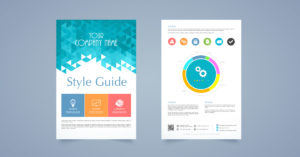
Consistent, recognizable brands have something in common. They all adhere to a style guide. Your brand style guide defines what your company’s brand elements are and how they should be applied across marketing materials. This key document helps your company communicate consistent visuals and messaging to your audience. It can dictate how copy should be written, state the distance a logo should be from an edge, and even address the type of photography style that should be used. A well-developed style guide is an essential tool for establishing brand identity. Your style guide is a single document that helps everyone within your company communicate the brand to your audience in a consistent, on-brand manner.
Why A Brand Style Guide Is Important
Brand guidelines communicate a variety of things about your brand, both internally and externally. Your brand style guide is a resource that outlines your company’s design standards for your whole group. This document informs your designers, writers, and developers, giving them a solid framework to use as a starting point for their work.
Marketing initiatives are bolstered by a style guide that ensures all messaging is not only relevant but related to your brand’s goals. You’ll be sure to create content that is cohesive and distinguishes your brand from your competitors. This cohesion is an important part of establishing a strong brand voice that resonates with your audience. Over time this cohesion and consistency build trust and brand awareness.
Global companies, in particular, can benefit dramatically from making their style guides available online. Make your style guide easily accessible by those who need it whenever and wherever they happen to
If your company goes through a brand redesign, it is essential for you to create a new brand style guide to complement your brand redesign. This updated style guide has the double benefit of announcing the rebrand to your team and getting everyone on-board with the new design guidelines.
What Is Included in a Brand Style Guide?
While the components a brand style guide contains is not standard, it should include all the important guidelines for your brand’s identity and voice. The most discernible organizations utilize style guides as a resource for everyone to understand how to represent their brand.
Style guides can contain sections on logo, color palette, typeface, spacing, and backgrounds as well as sections pertaining to your brand identity such as your mission, core values, personality, and tone.
Logo Design
Be sure to include the logo, along with how it should be displayed in different formats, as part of your style guide. These instructions could include size restrictions, which colors to use, and how your logo should be displayed on different backgrounds. You might have guidelines on how the logo should appear in relation to other assets, like taglines. It is also often helpful to show how logos should not be displayed. You never want to see your logo stretched in odd ways or placed on difficult-to-read backgrounds.
Color Palette
The colors that make up your brand should be included within your style guide. Colors require different values and settings on various printing processes and devices. Brand guidelines should include both RGB and CMYK color codes to ensure your colors stay consistent between web and print formats. Identify primary, secondary, and tertiary colors. Indicate any limited or single color versions of your logo. Be careful with your color palette; it can be wise not to use too many color options.
Typography
Any typefaces used within the logo and marketing materials should be part of the style guide. Your style guide should include typefaces and families, font sizes, and the hierarchy of the fonts your brand uses. Typefaces come in multiple weights and styles and can be manipulated in different ways, including uppercase, lowercase, bold and italics. All of which can affect the feel of your marketing materials. It’s also a good idea to provide web-safe font alternatives. Be sure to distinguish between fonts used for titles versus body copy, and include any formatting preferences for copy.
Web Styles
Websites frequently have dozens or hundreds of pages. It’s important to keep these pages looking cohesive. Your style guide will help your developers keep elements like buttons and forms consistent across multiple webpages.
Additional Elements That May Be Included
The length and specificity of your style guide will be determined by your company’s needs. Beyond your logo design, color palette, typography, and web styles, you might also consider including elements such as imagery or brand tone. Imagery could include the style of photographs or icons your company uses on your website or marketing materials. Brand tone refers to the words that your company chooses to use. You might also choose to include writing samples and a list of words to avoid. Choose carefully as this can be a lot to address within one document. Focus on covering the key points while keeping the document simple enough to scan and commit to memory.
Safeguard knows that without a style guide, it is nearly impossible to keep your brand’s identity consistent. By building strong guidelines, you can maintain a strong, cohesive, and distinguishable brand. Our in-house design studio can help you with everything from a logo to a complete brand identity package. Contact us today for visual solutions that will help your business succeed.